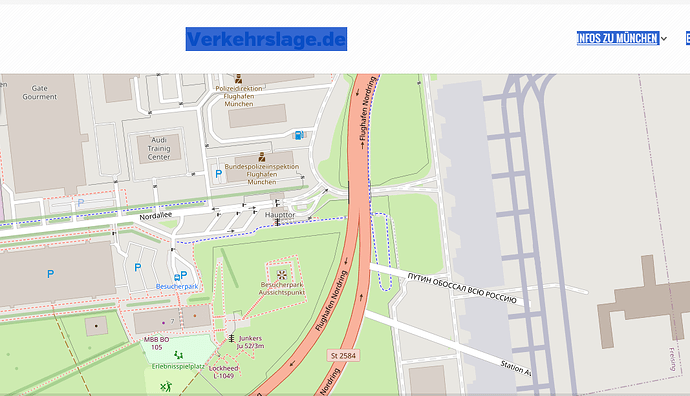I saw this on a website that uses OSM map data: Stau in München | Aktuelle Verkehrslage mit Karte Zoom in five times and pan to the airport (ghost streets appear in other locations, too, but the airport is easier to find). Ghost streets appear ONLY in this zoom level and disappear when changing zoom level. So either there is a corruption in the DB and records from a completely different location come up, or there is hack?
Colleagues tell me that they saw streets with cyrillic street names pop up in the middle of the alps, too…
Demonstration:
The cyrillic street name translates to “Putin pissed all of Russia”.
So far I did not check OSMs own page. I saw this on verkehrslage.de, and they claim that OSM is their data source.
from ukraine with love ![]()
I do not see this on OSMs own page, only on verkehrslage.de
It’s very likely that the data has been cached, either server-side or client-side (the latter can be checked by refreshing your cache i.e. Ctrl+F5). I’m sure it’s the latter because I don’t see the vandalism on my side.
It’s still there even after Ctrl-F5! It is only in the last but one (!) zoom level.
A DB admin could search for most of these by looking for street names with a codepage change to cyrillic for locations outside Russia/Belarus/Ukraine/Serbia etc. Or for Unicode in the range of cyrillic, if Unicode is used.
You mentioned that you don’t see the problem on osm.org, which means the issue is probably fixed in the database. That doesn’t mean it will immediately be fixed in renderers.
I don’t know if this is related, but that site may not be using the recommended tile URL as set out in Tile Usage Policy. I see a lot of references to a.tile.openstreetmap.org (and b. and c.) here, which I don’t think is up to date:
Technicalities aside, note that verkehrslage.de has chosen to use the free tiles provided by OSM which offer no guarantees.
Thanks for the explanation. Since colleagues of mine tell me they saw similar stuff, I think it could be a good idea to go through the DB and look for cyrillic text on coordinates outside the countries where cyrillic is used (mostly russian/Russia (plus Belarus, Ukraine etc.), but some few other east european languages and their countries as well). In Germany there can be no cyrillic street names, not possible.
Apologies if this reply sounds somewhat frustrated, but it would help if you read through the links that people have provided in answer with your questions. In particular they answer
- that the data in the database is fixed
- that remains of problems may appear in browser cache and in tiles cached by the CDN
- that third-party sites who have chosen to use OSM’s “mapper QA” tiles may see problems for longer than osm.org users will.
More specifically, OSM is a volunteer-run project. If you believe that you will find misplaced text in an area please look for it and if you find it, report it.
I have read these, thanks. But working as a quality manager in a larger IT operation here I wanted to point out that there is a method for DB admins to find these fakes even if no one reports them. There can be no cyrillic street names in Germany, so ALL cyrillic street names in Germany are fake and can be found by search on DB level with an apropriate SQL SELECT statement. Also, with this method the DB IMHO could be “immunized” against future vandalism.
Does your “larger IT operation” uses OSM data or sth. like e.g. tiles from OSM(F)?
I don’t know precisely (not a member of that project), but to my knowledge they use Google (which also has problems with incorrect user input, but so far I know no vandalism issue. In Google it’s mostly that companies add their company and wildly misplace the coordinates ![]() ) And Google just can’t get house numbers correct
) And Google just can’t get house numbers correct ![]()
Yes, both true ![]()
But about the problems in OSM: be assured that a lot of developers with a lot of expertise are working on this vandalism problem and on how to get more resilience against vandalism into this open project. Also a lot of developers of some of the biggest names in global IT.
So while we welcome anyone that wants to strengthen the project, you as a quality manager might understand that a thorough expertise and insight into the peculiar IT systems might be needed to improve those and this is not a “one small idea thrown into the ring solves the problem” situation.
That could be a very useful thing to do : today, one would need a serious investigation to find a timestamp “just before the wave”.
9 posts were split to a new topic: How organizations can host their own maps

